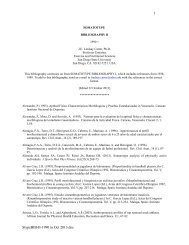THE HEATH-CARTER ANTHROPOMETRIC ... - Somatotype.org
THE HEATH-CARTER ANTHROPOMETRIC ... - Somatotype.org
THE HEATH-CARTER ANTHROPOMETRIC ... - Somatotype.org
Create successful ePaper yourself
Turn your PDF publications into a flip-book with our unique Google optimized e-Paper software.
<strong>Somatotype</strong> Instruction Manual 3<br />
pressures of 10 gm/mm 2 over the full range of openings. The Harpenden and Holtain calipers are highly<br />
recommended. The Slim Guide caliper produces almost identical results and is less expensive. Lange<br />
and Lafayette calipers also may be used but tend to produce higher readings than the other calipers<br />
(Schmidt & Carter, 1990). Recommended equipment may be purchased as a kit (TOM Kit) from<br />
Rosscraft, Surrey, Canada (email: rosscraft@shaw.ca, or www.tep2000.com).<br />
Measurement techniques<br />
Ten anthropometric dimensions are needed to calculate the anthropometric somatotype: stretch<br />
stature, body mass, four skinfolds (triceps, subscapular, supraspinale, medial calf), two bone breadths<br />
(biepicondylar humerus and femur), and two limb girths (arm flexed and tensed, calf). The following<br />
descriptions are adapted from Carter and Heath (1990). Further details are given in Ross and Marfell-<br />
Jones (1991), Carter (1996), Ross, Carr and Carter (1999), Duquet and Carter (2001) and the ISAK<br />
Manual (2001).<br />
Stature (height). Taken against a height scale or stadiometer. Take height with the subject<br />
standing straight, against an upright wall or stadiometer, touching the wall with heels, buttocks and back.<br />
Orient the head in the Frankfort plane (the upper border of the ear opening and the lower border of the<br />
eye socket on a horizontal line), and the heels together. Instruct the subject to stretch upward and to<br />
take and hold a full breath. Lower the headboard until it firmly touches the vertex.<br />
Body mass (weight). The subject, wearing minimal clothing, stands in the center of the scale<br />
platform. Record weight to the nearest tenth of a kilogram. A correction is made for clothing so that<br />
nude weight is used in subsequent calculations.<br />
Skinfolds. Raise a fold of skin and subcutaneous tissue firmly between thumb and forefinger of<br />
the left hand and away from the underlying muscle at the marked site. Apply the edge of the plates on<br />
the caliper branches 1 cm below the fingers of the left hand and allow them to exert their full pressure<br />
before reading at 2 sec the thickness of the fold. Take all skinfolds on the right side of the body. The<br />
subject stands relaxed, except for the calf skinfold, which is taken with the subject seated.<br />
Triceps skinfold. With the subject's arm hanging loosely in the anatomical position, raise a fold<br />
at the back of the arm at a level halfway on a line connecting the acromion and the olecranon processes.<br />
Subscapular skinfold. Raise the subscapular skinfold on a line from the inferior angle of the<br />
scapula in a direction that is obliquely downwards and laterally at 45 degrees.<br />
Supraspinale skinfold. Raise the fold 5-7 cm (depending on the size of the subject) above the<br />
anterior superior iliac spine on a line to the anterior axillary border and on a diagonal line going<br />
downwards and medially at 45 degrees. (This skinfold was formerly called suprailiac, or anterior<br />
suprailiac. The name has been changed to distinguish it from other skinfolds called "suprailiac", but taken<br />
at different locations.)<br />
Medial calf skinfold. Raise a vertical skinfold on the medial side of the leg, at the level of the<br />
maximum girth of the calf.<br />
Biepicondylar breadth of the humerus, right. The width between the medial and lateral<br />
epicondyles of the humerus, with the shoulder and elbow flexed to 90 degrees. Apply the caliper at an<br />
angle approximately bisecting the angle of the elbow. Place firm pressure on the crossbars in order to<br />
compress the subcutaneous tissue.<br />
Biepicondylar breadth of the femur, right. Seat the subject with knee bent at a right angle.<br />
Measure the greatest distance between the lateral and medial epicondyles of the femur with firm<br />
pressure on the crossbars in order to compress the subcutaneous tissue.




